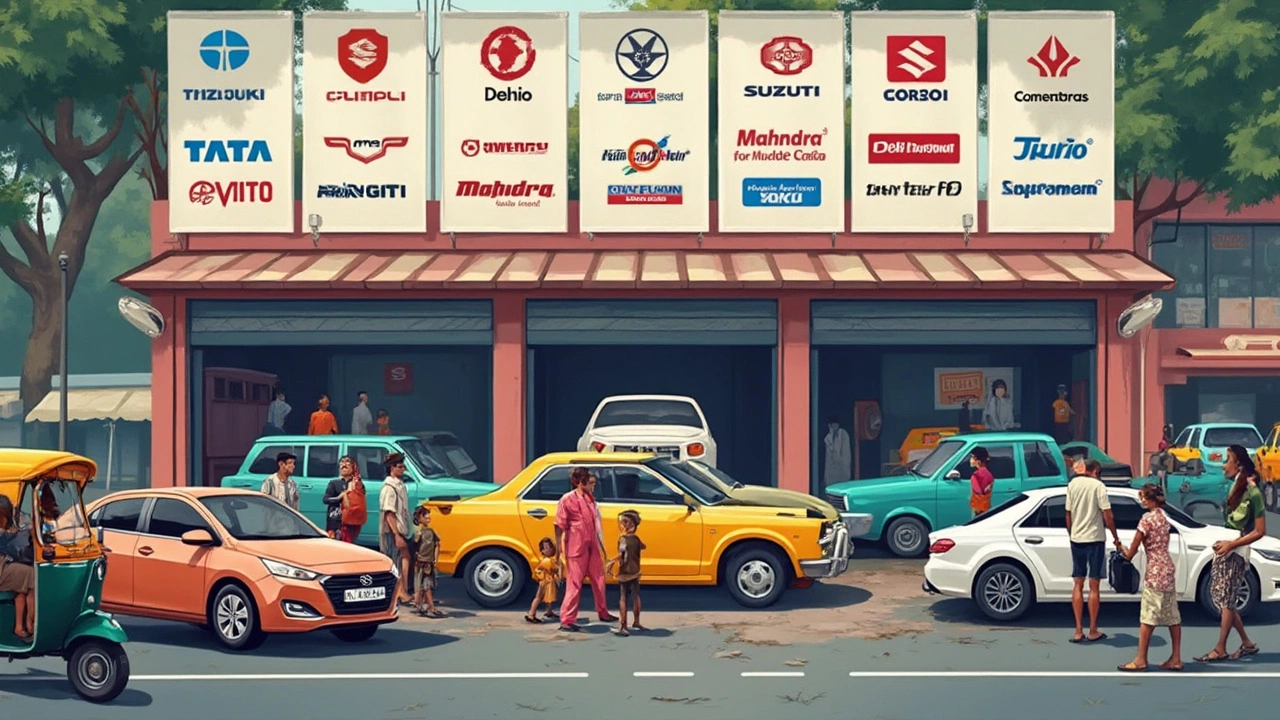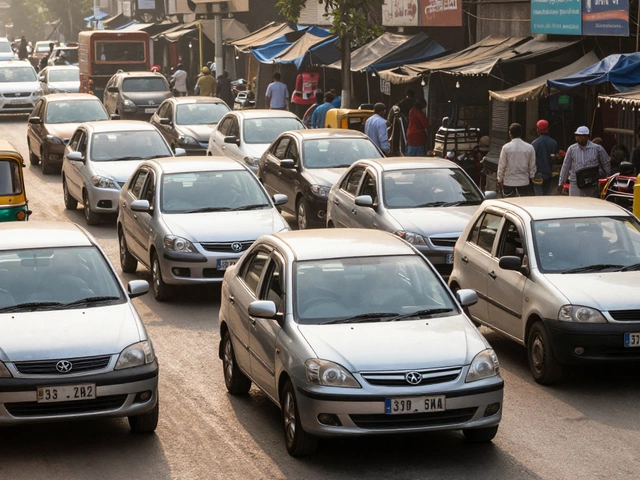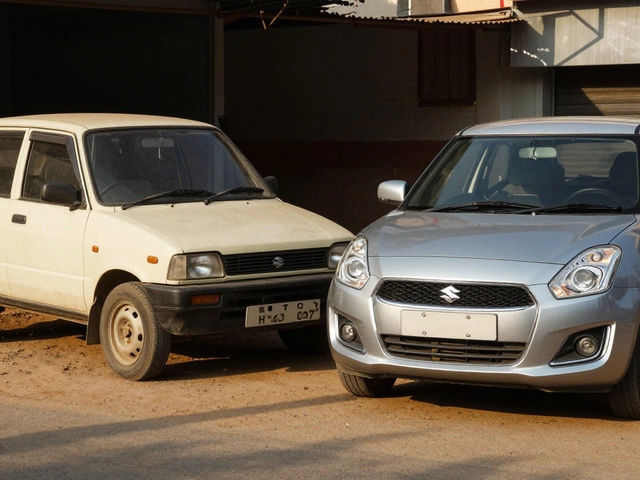Car Brands Made in India: Full List, Surprises, and What You Should Know

If you think all those shiny cars on Indian roads come straight from foreign factories, you’re off track. India has quietly become a powerhouse for car manufacturing. From compact hatchbacks to fancy SUVs, the country now makes models for almost every budget.
Here’s something wild: Over a dozen big brands, including some global names, actually build cars right here in India. And it's not just Tata or Mahindra. Even giants like Hyundai, Kia, Toyota, and Suzuki have massive plants from Chennai to Gujarat, pumping out lakhs of vehicles each year.
Why does this matter for you? Locally made cars usually offer better service support, cheaper spare parts, and shorter waiting periods. Plus, they’re often tailored to tackle Indian roads and traffic (yep, those extra-tough suspensions and ACs built for our summers).
Not all ‘made in India’ badges mean the same thing, though. Some brands do full-scale manufacturing, while others just assemble imported kits. Knowing who really builds here can help you buy smarter.
- Why Indian Manufacturing Matters
- The Full List: Car Brands Made in India (2025)
- Global Giants with Indian Plants
- Indian Originals: Homegrown Brands
- Made vs Assembled: The Real Difference
- Insider Tips for Indian Car Buyers
Why Indian Manufacturing Matters
Let’s get real—Indian car manufacturing is a big deal, for the country and for anyone buying a car here. First off, it’s not just about pride. The car industry in India supports over 37 million jobs, directly and indirectly. That’s not small change. It’s one reason many global brands want to set up shop in Indian cities like Pune, Chennai, and Gurgaon.
Then there’s pricing. When cars are made in India, they dodge high import duties and taxes. This usually means better value and more options for you, right on your doorstep. Ever wonder why a Hyundai or Suzuki feels priced just right here compared to import-heavy brands? That’s the local manufacturing edge.
Another thing—when cars are built and designed to handle Indian roads, they last longer. Models get extra tweaks: higher ground clearance for those famous urban potholes, heavy-duty cooling for hot summers, and dust filters for our air. So local cars aren’t just cheaper; they’re tougher too.
Now, manufacturers aren’t just selling these cars here. India has become the world’s third-largest car producer, pushing out vehicles for export to 100+ countries. Check out the numbers—this should give you a sense of how massive the scene is:
| Year | Cars Produced in India | Cars Exported |
|---|---|---|
| 2021-22 | 3.65 million | 577,875 |
| 2022-23 | 4.43 million | 671,384 |
| 2023-24 | 4.89 million | 754,216 |
Bottom line? The car brands India spotlight isn’t just about variety or cool badges. Every time you pick a car made here, you’re getting better value, more reliability, and a little push for the local economy, all rolled into one.
The Full List: Car Brands Made in India (2025)
When we talk about car brands India, it’s not just a handful anymore. There are around 16 car brands that manufacture or assemble vehicles on Indian soil as of June 2025. Some you probably drive or spot daily—others might surprise you. Here’s a breakdown of the main players making cars for the Indian market:
- Maruti Suzuki: The reigning champ in sales, cranking out everything from Altos to Grand Vitaras in places like Manesar and Gujarat.
- Hyundai: Their Chennai factory is packed, pushing out models like the Creta, i20, and Verna.
- Tata Motors: A truly homegrown player, with big plants in Pune, Sanand, and more, making Nexon, Punch, and Harrier.
- Mahindra & Mahindra: Known for SUVs and utility vehicles, famous for models like the XUV700 and Scorpio.
- Kia: Their Anantapur plant has made Kia a household name, especially with the Seltos and Sonet.
- Honda Cars India: Still going strong with the Amaze and City from their Rajasthan plant.
- Renault: The French brand makes the Kwid and Triber in Chennai.
- Nissan: Shares manufacturing space with Renault, producing Magnite and Kicks.
- MG Motor: Assembles Hector, Astor, and ZS EV in Halol, Gujarat.
- Skoda-Volkswagen Group: They share facilities in Chakan, Pune and Aurangabad. Slavia, Virtus, Taigun, Kushaq—the list is growing.
- Toyota Kirloskar Motors: Their Bengaluru plant makes the Innova HyCross, Fortuner, and now compact SUVs.
- BYD: All-electric cars assembled at their Chennai-based plant.
- Citroen: The French challenger, now rolling out the C3 and C3 Aircross in Tamil Nadu.
- Force Motors: Best known for the sturdy Gurkha SUV.
- Isuzu: Their Andhra Pradesh plant builds sturdy pickup trucks and SUVs.
- Mercedes-Benz India: Local assembly for luxury models like E-Class, S-Class, and GLC in Pune.
To back all this up, here’s a simple table showing where these brands actually build or assemble their cars:
| Car Brand | Main Plant Location(s) | Main Models Made/Assembled |
|---|---|---|
| Maruti Suzuki | Manesar, Gurgaon, Gujarat | Swift, Baleno, Brezza |
| Hyundai | Chennai | Creta, i20, Verna |
| Tata Motors | Pune, Sanand | Nexon, Punch, Harrier |
| Mahindra & Mahindra | Nashik, Chakan | XUV700, Scorpio |
| Kia | Anantapur | Seltos, Sonet |
| Honda | Tapukara (Rajasthan) | Amaze, City |
| Renault-Nissan | Chennai | Kwid, Magnite |
| MG Motor | Halol (Gujarat) | Hector, Astor, ZS EV |
| Skoda-Volkswagen | Pune, Aurangabad | Slavia, Virtus, Kushaq, Taigun |
| Toyota | Bidadi (Bengaluru) | Innova, HyRyder, Fortuner |
| BYD | Chennai | e6, Atto 3 |
| Citroen | Tamil Nadu | C3, C3 Aircross |
| Force Motors | Pithampur (MP) | Gurkha |
| Isuzu | SriCity (AP) | D-Max, MU-X |
| Mercedes-Benz | Pune | E-Class, S-Class, GLC |
Watch this space—EV brands and even a couple of startups are expected to join the list over the next year as India pushes for cleaner mobility. For now, this is your A-to-Z on which wheels are genuinely made or assembled right here in India.
Global Giants with Indian Plants
Big international carmakers aren’t just selling cars in India—they’re actually building them here. This move isn’t just about saving on import duties. Indian plants churn out models not only for local buyers but, in some cases, for export too.
If you check the factory list, it’s pretty impressive:
- Hyundai set up shop in Chennai and became India’s second-largest car maker. Their plant doesn’t just make the i20, Creta, and Venue—it also supplies other countries in Asia and Africa.
- Kia has a high-tech plant in Andhra Pradesh. In just a few years, their Seltos and Sonet turned into go-to models for a new set of Indian buyers.
- Toyota builds a mix of segment leaders (like the Innova HyCross) in Karnataka. Several models use parts made almost entirely in India.
- Maruti Suzuki (technically an Indo-Japanese venture) is by far the biggest. Their Haryana and Gujarat plants roll out crowd favorites like the Baleno, Swift, and Brezza. In fact, they produced over 1.5 million vehicles in fiscal year 2024-25 alone.
- Renault-Nissan has a joint plant near Chennai. You’re looking at cars like the Renault Kwid or Nissan Magnite having deep Indian roots.
- Honda and Volkswagen-Skoda also run full manufacturing operations (not just assembly) in North and West India.
Seeing numbers can help. Here’s a simple table showing annual output from major global brands’ Indian plants (2024-25 figures):
| Brand | Main Plant Location | Annual Production (Vehicles) |
|---|---|---|
| Maruti Suzuki | Haryana, Gujarat | 1,580,000 |
| Hyundai | Chennai, Tamil Nadu | 750,000 |
| Kia | Anantapur, Andhra Pradesh | 350,000 |
| Toyota | Bidadi, Karnataka | 225,000 |
| Renault-Nissan | Chennai, Tamil Nadu | 250,000 |
| Volkswagen-Skoda | Pune, Aurangabad | 115,000 |
Why does this matter? Well, cars built here often adapt better to local demands—think sturdier air conditioning, higher ground clearance, or engines tweaked for Indian fuel. For anyone shopping for a new ride, picking from a car brands India list with local manufacturing can save a tonne of trouble (and money) down the line.

Indian Originals: Homegrown Brands
When you hear about "made in India cars," brands like Tata Motors and Mahindra & Mahindra jump out. These two companies aren't just selling cars here—they’re designing them, building them from scratch, and even shipping them out globally. Walk down any street and you’ll spot Tata’s SUVs like the Nexon or Mahindra classics like the Scorpio.
Tata Motors shook everyone up by launching the Nexon EV, making electric cars a real option for a regular Indian family. Before this, EVs sounded like a luxury add-on. Mahindra, not to be left behind, has kept people excited with the XUV, Thar, and Bolero. Both brands are serious about safety; Tata and Mahindra models consistently get high marks in crash tests, unlike many foreign rivals that just meet the legal minimum here.
But these two aren’t alone anymore. Force Motors builds sturdy people carriers and off-road vehicles, mainly for rural and commercial uses. Then there’s Ashok Leyland—while best known for trucks and buses, they’ve chipped in to the smaller, personal vehicle market too.
Premier, another name from the past, isn’t really active now but deserves a mention for being one of the first to make mass-market cars in India with models like the Padmini. Newer startups like Ola Electric have big plans for 2025, especially for city commuters hunting for affordable EVs.
- Indian car brands are now investing in electric and hybrid tech, so expect more budget-friendly EVs rolling out in the next few years.
- Buying from a homegrown brand often means better resale value and easier access to spares, thanks to dense service networks.
- Many cars designed by Indian brands have stronger suspensions and air conditioning to handle our rough roads and extreme weather.
Long story short: Indian brands aren’t just holding their ground—they’re carving out new roads, both here and abroad.
Made vs Assembled: The Real Difference
Most people lump “made in India” and “assembled in India” together, but there’s actually a big difference. Here’s the deal: when a car is truly made in India, that means most of its parts are manufactured here, from the body panels to the engine and even the electronics. When a brand only assembles cars in India, it’s usually bringing in kits or big chunks of the car from abroad and just putting them together at an Indian facility.
This isn’t just about the sticker on the boot. Genuine local manufacturing boosts jobs, makes spare parts cheaper and keeps more of your money in the local economy. Assembly-only operations, called CKD (Completely Knocked Down) or SKD (Semi Knocked Down), mainly focus on saving imports taxes, with limited local sourcing.
Want to know which brands do which? Here’s a quick breakdown for 2025:
| Brand | Mostly Made in India | Mostly Assembled in India |
|---|---|---|
| Tata Motors | Yes | No |
| Maruti Suzuki | Yes | A few imported models |
| Hyundai | Yes | Certain premium models |
| Kia | Yes | — |
| Skoda & Volkswagen | Mostly assembly | Yes |
| Mercedes-Benz, BMW, Audi | No | Yes (CKD/SKD) |
| Mahindra | Yes | No |
These details change sometimes, as brands shift towards deeper localization to lower costs or dodge global supply chain drama. A strong local manufacturing footprint also means the company is taking the Indian market seriously, not just passing through.
So next time you see that "made in India" ad, check if it's actual manufacturing, or just smart packaging. If your priority is after-sales support, price, or easy spare part availability, a car brand India that's really manufacturing here will usually score better.
- If you care about market support and affordable ownership, aim for brands making most parts in India.
- If you want luxury or rare models, assembly might be the best you’ll get for now.
- Always ask the dealer where the model you want is actually put together—and check if the service network matches your city.
Insider Tips for Indian Car Buyers
Picking the right car is a big decision, so you want real intelligence—especially with all the choices from brands actually making cars in India. Here are things that can honestly save you hassle, money, and regrets down the road.
- car brands India: Always check if your short-listed car is genuinely made in India or just assembled here. Check the VIN plate or ask the dealer straight up. Local manufacturing can mean better support and resale.
- Don’t fall for the "latest launch" trap. New models, especially from brands that are new to Indian manufacturing, sometimes come with teething problems. Established players (like Maruti Suzuki, Tata, Hyundai) have a better track record on reliability.
- Spare parts availability is a big deal. Locally manufactured brands like Tata and Mahindra usually offer cheaper and more easily available spares. Imported or low-localization brands can make you wait weeks—and pay more—when something breaks.
- Always ask about crash test ratings. Not all Indian-made models are created equal. Living-room rumors aren't enough: Check sources like Global NCAP for real crash safety scores.
- Service network can make or break your ownership. Tally how many service centers each brand has in your city and nearby towns. Maruti Suzuki tops the list with over 2,800 service points across India.
Here’s a quick comparison of how major car brands stack up in terms of service reach and spare part costs, two things you’ll care about much more than fancy tech after a year or two.
| Brand | Number of Service Centers (2025) | Spare Parts Cost Index* | Local Manufacturing |
|---|---|---|---|
| Maruti Suzuki | 2800+ | Low | Yes |
| Hyundai | 1400+ | Medium | Yes |
| Tata Motors | 1100+ | Low | Yes |
| Mahindra | 900+ | Low | Yes |
| Honda | 350+ | Medium-High | Yes |
| Kia | 400+ | Medium | Yes |
*Spare Parts Cost Index: Relative to local income, based on routine parts like filters, brakes, and lamps ("Low" means more affordable, “Medium” is average, “Medium-High” can get expensive fast).
One last thing—don’t ignore the local dealership's reputation. Even if a brand scores high for everything else, a sketchy dealer can ruin your experience. Check Google reviews, ask your neighbors, or just drop by the workshop and see for yourself.
In short, choose a car that’s not just cool on launch day, but actually works for how—and where—you’ll be driving in India. It makes a world of difference.





